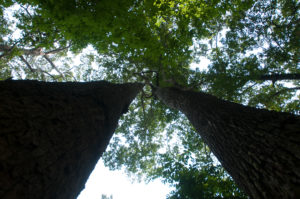From carbon sequestration to storm surge protection, trees matter every step of the way

As the 28th UN climate conference (COP28) approaches, and countries prepare to take stock of progress in emission reduction since the adoption of the Paris Agreement through the first Global Stocktake (GST), measures to mitigate the advance and impacts of climate change are in the spotlight.
These measures are wide-ranging and touch on many elements of our daily lives, such as renewable energy, sustainable transport, and more climate-friendly diets and food systems.
But one of the most important solutions is often hiding in plain sight. That tree outside your window? On average, it’s putting away about 21 kilograms (48 pounds) of carbon dioxide, and releasing oxygen in exchange.
Here are five reasons why trees must be valued as a critical part of the solution to the climate crisis.
We need to go beyond net zero – and trees can help
Reaching “net zero” emissions (where greenhouse gas emissions are cut to as close to zero as possible, and any remaining emissions are reabsorbed from the atmosphere) is a big focus in the current climate talks.
“But net zero is not enough,” said Anja Gassner, the director for Europe of the Centre for International Forestry Research and World Agroforestry (CIFOR-ICRAF), in a media seminar in October 2023. “We don’t just have to slow down the amount of emission that we are actually putting into the atmosphere. We actively have to draw the carbon dioxide down.”
Trees are great at doing that. To survive and grow, they bind carbon from the atmosphere in their trunks and roots. They also improve the functionality of the soil they sit it, meaning it can stash more carbon for longer periods, too.
Trees can improve food and nutrition security for climate-vulnerable communities
Acute food insecurity has risen dramatically in recent years, and unusual and unpredictable weather is a key driver – especially for the world’s smallholder and subsistence farmers. In the absence of sustainable solutions, falling crop yields will push more people into poverty – in Africa alone, an estimated 43 million people could fall below the poverty line by 2030 as a result.
Trees can help here, too. CIFOR-ICRAF’s research shows that forests, trees, and agroforestry play key – and often undervalued – roles in supporting food security and nutrition.
These roles include contributing to incomes and employment; boosting dietary diversity; providing bioenergy (in the form of fuelwood and/or charcoal) for cooking and boiling water; and performing ecosystem services that are critical for agriculture and food production, such as keeping watersheds functional and boosting soil health and fertility.
There are so many places we can put more trees
Many of us are aware of the importance of preserving intact primary forests, which is often home to unique biodiversity and extensive stores of carbon.
But planting and preserving trees in agricultural landscapes is also extremely worthwhile for biodiversity conservation, as the Trees on Farms (TonF) project emphasises and promotes – and maintaining the ecosystem services that keep carbon in the ground.
Agroforestry offers a compelling approach to meeting food security, livelihood, and climate mitigation needs, by storing an average of 8.4 tonnes of carbon per hectare per year. Meanwhile, “even small incremental increases in global tree cover on agricultural land could provide short-term respite to carbon accumulation in the atmosphere, benefiting the livelihoods of smallholder farmers, biodiversity, ecosystems, and ecosystem services,” according to an international, multidisciplinary 2022 study.
Planting and protecting trees makes financial sense
Cleaning up the messes caused by climate change is extremely expensive and set to become more so, as governments around the world are already well aware. In this context, investing in trees, forests, and agroforestry makes sound financial sense. For instance, the $800 million investment made in the 10-year CGIAR Research Programme on Forests, Trees and Agroforestry (FTA) between 2011 and 2021 was conservatively estimated to bring $240 billion in economic returns and avoided losses, by enhancing protection for forests, restoring degraded land, improving management, and helping boost food security, nutrition, and livelihoods. That’s a lot of value for money.
Trees can help build communities’ resilience to climate change impacts
Extreme weather events have already shown us that trees can offer up much-needed protection as climate threats increase. Mangroves, for instance, play a key role in mitigating the impact of storm surges on vulnerable coastal communities, while trees in water-scarce areas help to regulate the climate and boost soil water storage capacity.
What’s more, by providing habitats for biodiversity, the presence of trees also boosts the chances that some of the species they harbour will be able to adapt to a changing environment – thus helping to nourish the ecosystems of the future and ensure they can serve life and livelihoods for generations to come.
By Monica Evans, Forest News
This article was originally published in Forest News here: https://forestsnews.cifor.org/84571/explainer-five-reasons-why-trees-are-a-solution-to-the-climate-crisis?fnl=&utm_campaign=CIFOR_ICRAF_Newsletter&utm_med
